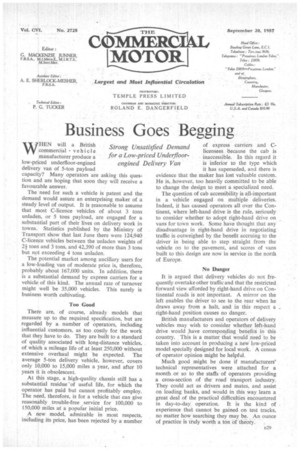Business Goes Begging
Page 37

If you've noticed an error in this article please click here to report it so we can fix it.
Strong Unsatisfied Demand for a Low-priced Underfloor:engined Delivery Van WHEN will a British commercial vehicle manufacturer produce a low-priced underfloor-engined delivery van of 5-ton payload capacity? Many operators are asking this question and are hoping that soon they will receive a favourable answer.
The need for such a vehicle is patent and the demand would assure an enterprising maker of a steady level of output. It is reasonable to assume that most C-licence vehicles of about 3 tons unladen, or 5 tons payload, are engaged for a substantial part of their lives on delivery work in towns. Statistics published by the Ministry of Transport show that last June there were 124,940 C-licence vehicles between the unladen weights of 21 tons and 3 tons, and 42,390 of more than 3 tons but not exceeding 4 tons unladen.
The potential market among ancillary users for a low-loading van of moderate price is, therefore, probably about 167,000 units. In addition, there is a substantial demand by express carriers for a vehicle of this kind. The annual rate of turnover might well be 35,000 vehicles. This surely is business worth cultivating.
Too Good There are, of course, already models that measure up to the required specification, but are regarded by a number of operators, including influential customers, as too costly for the work that they have to do. They are built to a standard of quality associated with long-distance vehicles, of which a mileage life of at least 250,000 without extensive overhaul might be expected. The average 5-ton delivery vehicle, however, covers only 10,000 to 15,000 miles a year, and after 10 years it is obsolescent.
At this stage, a high-quality chassis still has a substantial residue of useful life, for which the operator has paid but cannot profitably employ. The need, therefore, is for a vehicle that can give reasonably trouble-free .service for 100,000 to 150,000 miles at a popular initial price.
A new model, admirable in most respects, including its price, has been rejected by a number. of express carriers and Clicensees because the cab is inaccessible. In this regard it is inferior to the type which it has superseded, and there is evidence that the maker has lost valuable custom. He is, ,however, too heavily committed to be able to change the design to meet a specialized need.
The question of cab accessibility is all-important in a vehicle engaged on multiple deliveries. Indeed, it has caused operators all over the Continent, where left-hand drive is the rule, seriously to consider whether to adopt right-hand drive on vans for town work. Some have thought that any disadvantage in right-hand drive in negotiating traffic is outweighed by the benefit accruing to the driver in being able to step straight from the vehicle on to the pavement, and scores of vans built to this design are now in service in the north of Europe.
No Danger It is argued that delivery vehicles do not frequently overtake other traffic and that the restricted forward view afforded by right-hand drive on Continental roads is not important. A mirror on the left enables the driver to see to the rear when he draws away from a halt, and in this respect a right-hand position causes no danger.
British manufacturers and operators of delivery vehicles may wish to consider whether left-hand drive would have corresponding benefits in this country. This is a matter that would need to be taken into account in producing a new low-priced model specially designed for local work. A census of operator opinion might be helpful.
Much good might be done if manufacturers' technical representatives were attached for a month or so to the staffs of operators providing a cross-section of the road transport industry. They could act as drivers and mates, and assist on loading banks, and would in this way learn a great deal of the practical difficulties encountered in day-to-day. operation. It is the kind of experience that cannot be gained on test tracks, no matter how searching they may be. An ounce of practice is truly worth a ton of 'theory. ,
















































































































